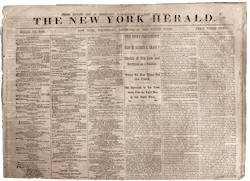April 22, 1863, The New York Herald
The Recent Fighting on the Nansemond River.
Our Suffolk Correspondence.
SUFFOLK, Va., April 20, 1863.
At sunset yesterday afternoon, a portion of the force under command of General Getty, accomplished quite a feat of daring.
Major General Peck for two days past has been watching a good opportunity to launch out upon the enemy’s lines, with the view to the striking of a quick, sharp and decisive blow.
On Sunday morning the enemy opened on our gunboats from one of his earthworks, about eight miles down the Nansemond river. The gunboats immediately replied, and in less than two hours the engagement ceased, our forces, land and water, having completely silenced that of their adversaries. The firing from the gunboats was so accurate that the parapets of the enemy works were deeply plowed with shot, and cut away in some thirty or forty places.
Just about dusk on Sunday evening our gunboats again opened with much vigor of firing upon the enemy’s line of batteries. He replied in good earnest. Thus matters remained in this direction for nearly an hour. While this was going on a couple of gunboats that had come to an anchorage, just around the turn of the point of land on which the enemy’s batteries were located, came together in such a manner as to make a tolerable safe bridge across the water of the Nansemond river. In this way two detachments of infantry, numbering in all about four hundred men (one detachment being from the Eighth Connecticut regiment and the other from the Eighty-ninth New York Volunteers), passed over to the opposite bank. As soon as the rebels were come upon in any force our men fired one volley and charged at the point of the bayonet. The enemy, on finding himself hemmed in, surrendered, after a very brief but spirited resistance. The Eighty-ninth charged a battery of six pieces and captured it, while the other detachment took a number of prisoners. This artillery was known as the “Farquier County Battery,” and comprised three 12-pounders and three 24-pounders.
The captured force belonged to Gen. Law’s brigade, of Major General Flood’s division.
The captured officers names are as follows: –
Captain Robert M. Stirpling, commanding battery.
Lieutenants Wm. C. Marshall, M. M. Rogers and T. M. Archer, also of the battery.
Captain D. L. Bowasman, Company A, Forty-fourth Alabama.
Lieutenants D. B. Edwards, Geo. Reese, A. A. Thornton and Jacob Goodwin, Forty-fourth Alabama conscripts.
We had three killed and twelve wounded in the charge.
The captured officers say they are perfectly mystified as to Gen. Longstreet’s movements. When they came in sight of Suffolk the general impression among the army was that the federal works there would be immediately assaulted.
They say that the firing of our sharpshooters was so accurate as to keep them at times from working their guns; that the railroad is not in operation from the Blackwater down to their present location, and, that two divisions left the Army of the Rappahannock and marched all the way from that locality to this one.
An interesting marriage ceremony took place on Sunday evening between Mr. Wm. Reed, of the Ninth regiment New York (Hawkins Zouaves), and a Miss Sarah Holland, of Suffolk. The ceremony was performed by the Rev. D. Henry Miler, chaplain of the Fifteenth regiment, C. V. The bride is spoken of as youthful and beautiful. New York is to be the future home of the happy pair. I believe this is a relative of Alderman Reed, of New York.
All the prisoners now in our possession will be sent to Fortress Monroe to- day. The following are additional names of those wounded: –
______Glancy, Company F. Ninety-ninth New York Volunteers, gunshot wound in the leg.
Jacob Menz, Company D, gunshot wound in the mouth; dangerously.
We received a Richmond paper yesterday, which states, in an editorial, that General Longstreet has one of the finest armies in the confederacy; that Suffolk is to be made too hot for the Yankees; that no fears need be entertained on this point; and that the hearts and hopes of the Southern people, now that General Longstreet has been elevated to a lieutenant generalship, are with him in all his movements against […..] enemy.”
The same paper states that the Confederates had possession of Washington, North Carolina.
Some of the traders around town are not yet over their scare. Three sold out to-day to Mr. J. J. Benson, sutler of the First New York Mounted Rifles. Mr. B., has also bought out several of the scared ones at the lowest possible rates, and is realizing handsomely by the operation. It is a fine thing to see a business man of pluck, energy and foresight in times, like these, of danger.
Our Norfolk Correspondence.
NORFOLK, Va., April 20, 1863.
A great deal of excitement has prevailed in this city all day. Large crowds have thronged the streets as each train from Suffolk arrived, to see the secesh prisoners that were expected down.
Our Fortress Monroe Correspondence.
FORTRESS MONROE, April 20, 1863.
The pilot of the lost iron-clad Keokuk was sent north to-night on the Baltimore boat, under guard. He is to be taken to Washington.
